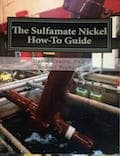
Curated with aloha by
Ted Mooney, P.E. RET

The authoritative public forum
for Metal Finishing 1989-2025

-----
Nickel sulfamate plating bath chemical analysis
Q. I am a semi-retired analytical/physical chemist doing volunteer work at the Alabama A&M Research Institute. I am attempting to analyze a nickel sulfamate plating bath by voltammetry and would appreciate any information on where I might find methods of analysis for metals plating baths by voltammetry.
Thank you for any help.
Hollis BowmanAlabama A&M Research Institute - Hazel Green, Alabama
2004
|
A. My first thought was that the concentration is far too high for decent results if your definition of voltammetry is the same as mine. This is not a common method to use for bath analysis. You might contact the manufacturer of the instrument tech services to see if they have an established procedure. A second thought would be to contact the international nickel institute. James Watts- Navarre, Florida 2004 A. I would try reading up on products from a company we have purchased many excellent products for our plating analysis namely Metrohm...who supply just the sort of apparatus you might be looking for. Nigel Gill, B.Sc MIMF MRSC- Glasgow, Scotland 2004 |
2004
![]() Dear Readers,
Dear Readers,
I would like to thank very much those who responded to my e-mail questions regarding Watts plating bath voltammetry. After addressing the points you made I was able to find several sources of good information on the Internet. These include: finishing.com, princetonappliedresearch.com, metrohm.com, and circuitree.com.
After reviewing applications and application notes, I:
1. Diluted the plating bath solution 1/100 to 1/1000.
2. Instrument: Bioanalytical Systems, Inc. CV50W Cyclic Voltammeter with Controlled Growth Mercury Electrode (CGME).
3. Method: Osteryoung Square Wave Voltammetry.
4. Initial E: -750 mV, Final E: -1250 mV.
5. Standards: 1000 ppm Ni and Co spectroscopic standards diluted to 5 and 10 ppm.
After considerable manipulation I obtained an analyte and supporting electrolyte concentration to give an acceptable Ni and Co spectrum (voltammogram).
Again, thanks for pointing me in the right direction.
Sincerely,
Hollis Bowman [returning]chemist/consultant - Hazel Green, Alabama
adv.

"The Sulfamate Nickel How-To Guide"
by David Crotty, PhD
& Robert Probert
published Oct. 2018
$89 plus shipping
Q, A, or Comment on THIS thread -or- Start a NEW Thread